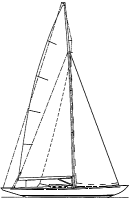Taylor 8-Meter Class Sloop
Racer-cruiserr
Jim Taylor worked with client Bruce Dyson to produce an alternative boat. The boxy, amputated ends of the IMS type have been avoided; instead, designer and client went to the old 8-meter rule. This simple rule is almost identical to the 12-meter rule. It has its own measurement quirks, but they can be fun for the designer, and they determine the overall character of the boat.
The meter rule produces heavy, skinny boats with long overhangs and deep midsections. Beam is directly limited, so you design to the maximum allowable beam. Length is controlled by profile waterline measurements, and the overhangs (while not exactly rating-free) are a good way to try to add sailing length. Meeting the displacement target is a function of designing a midsection that shows minimal difference in "chain girth" (A simple explanation would be girth measured as if holding a chain from sheer to sheer) compared to "skin girth" (girth measured along the skin of the boat), the girth difference being added to the length factor. The rule dictates a minimum displacement for the waterline length. Simply put, the meter rule produces boats that are the antithesis of IMS and sport boats. The D/L of this design is 287.
You can easily see the distended bustle aft of the keel fin. This is an attempt to spread out the required displacement and increase the prismatic coefficient. That's precisely where bustles came from. The beauty of the meter rule is just that; beauty. Long, skinny boats with low freeboard are beautiful and conform to most of our concepts for classical proportions in yachts.
How do they sail? In a word, sweet. They show a near neutral helm and are very stiff. They heel the first 15 degrees quite easily, and this puts the leeward-sitting helmsman's nose right down near the water for an incredible sense of boat speed. They go to weather like no other and are rockets in light air. They are limited to nonplaning speeds but, in rare instances, they will surf briefly. They do not pound, and they negotiate a swell with dignity and aplomb.
This 8-meter has the accommodations plan of a modern 30-footer, but it has better headroom due to the deep midsection. Everything is there for very comfortable cruising, including a proper galley. There is an engine, but this is the type of boat you would feel compelled to sail in and out of the slip.
There is sufficient interest at this time to indicate that more of Jim's 8s will be built. It would make a wonderful one-design while still being rule-legal to compete in any 8-meter class races. This one's a "10."

Comments